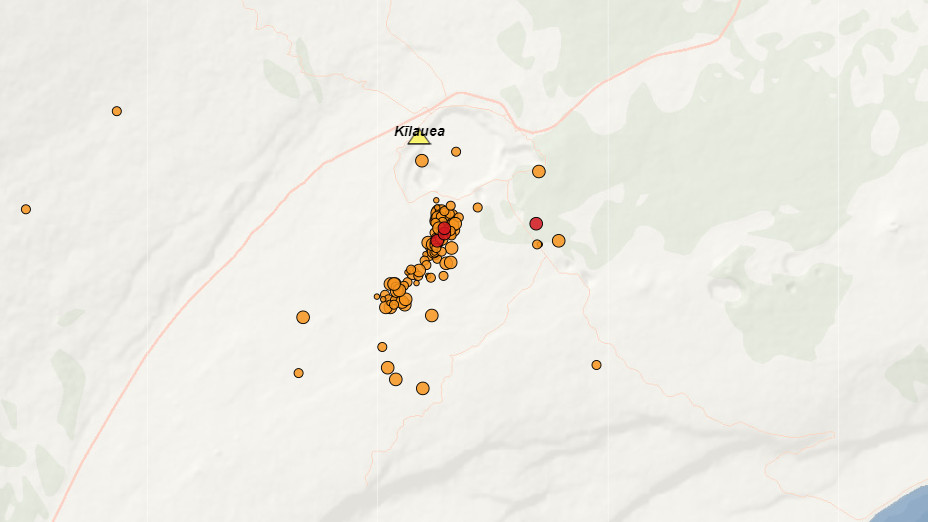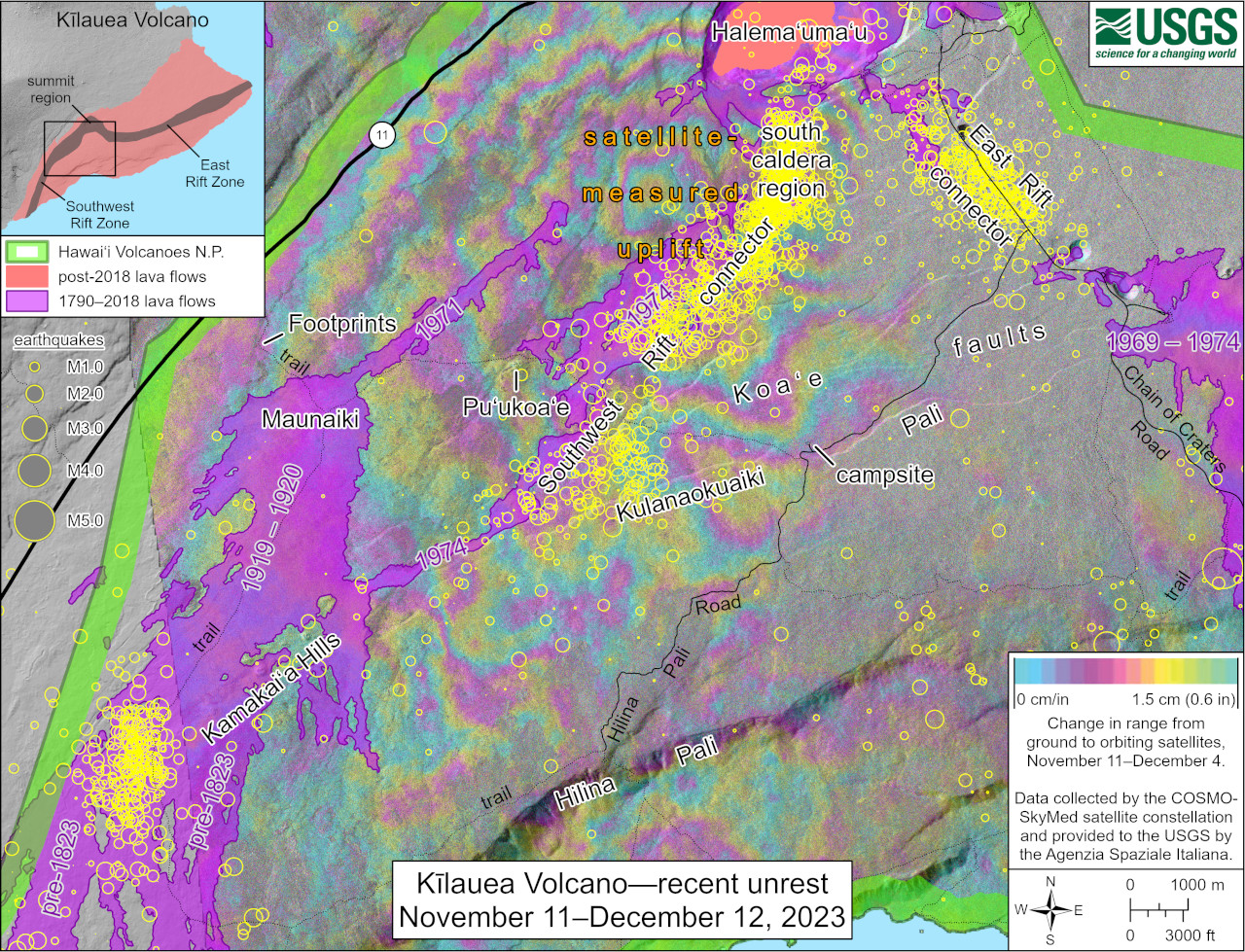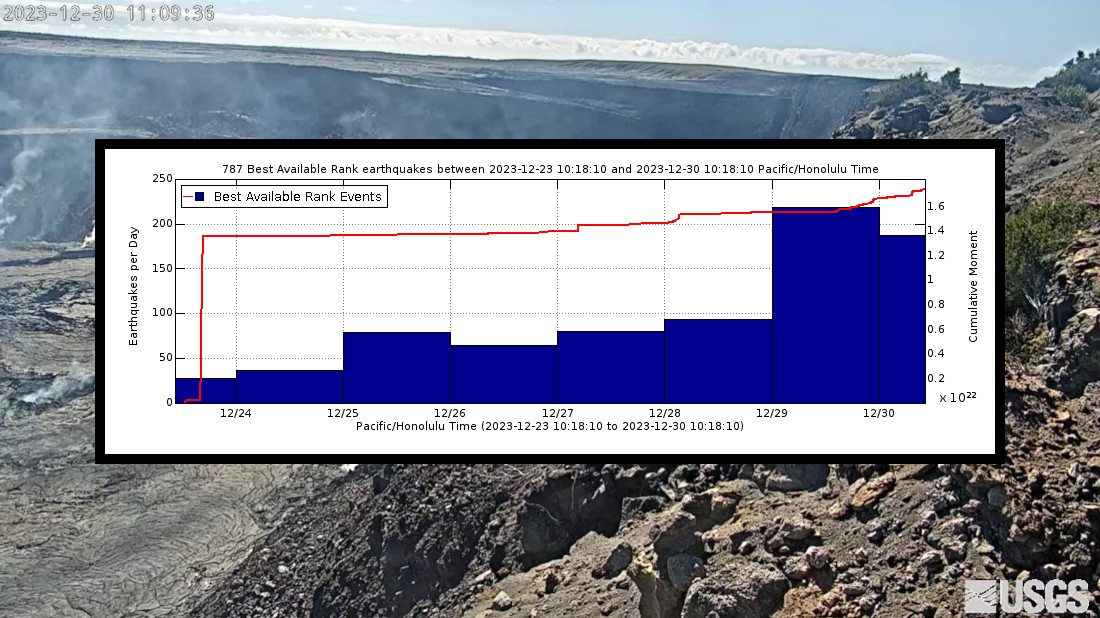
Image of the interactive map by USGS on December 30 that shows the location of the earthquake activity south of Kīlauea caldera over the past two days. Red circles are quakes that occurred in the last two hours.
(BIVN) – A high rate of seismicity is being recorded in the southern summit region of Kīlauea volcano, although as of Saturday morning scientists say there are still no signs of an imminent eruption. The Kīlauea alert level remains at ADVISORY.
Over 350 earthquakes have occurred in the southern part of Kīlauea’s summit region since 1:10 p.m. on December 29, when the latest wave of unrest abrupty began.
One of the USGS tiltmeters monitoring Kīlauea also began recording an increased rate of inflation, starting around noon on Friday. The high rate of inflation continued into Saturday.
As of Saturday morning, there were no new closures reported in Hawaiʻi Volcanoes National Park due to the elevated unrest. Seismicity in the upper East Rift Zone is moderate, scientists say, and low along the Southwest Rift Zone.
From the USGS Hawaiian Volcano Observatory update posted on Saturday:
Summit Observations: Seismicity in the southern part of Kīlauea’s summit region increased abrupty beginning at 1:10 p.m. yesterday, December 29, shortly after an increase in tilt t Sand Hill (see USGS HVO Information Statement — Kīlauea summit unrest | U.S. Geological Survey). Since then, roughly 350 earthquakes, most less than M2.5, have been occurring at depths of 1–3 km (0.5–2 mi). The increased seismicity began just south of Halemaʻumaʻu and the area has progressively widened to the southwest towards the Koʻae fault zone. The current rate of earthquakes is slightly higher than what was seen in October during the unrest that accompanied the magma intrusion in this area. Earthquakes are continuing with slight variations in rate and size in this region. Periods of incresed or decreased numbers of shallow earthquakes can be expected to continue during repressurization of the summit magma reservoir, which has been ongoing since the end of the September eruption. Seismicity has not reached the levels that immediately preceded recent summit eruptions at Kīlauea.
Yesterday around 12:30 p.m. HST, the Sand Hill tiltmeter located just south of the caldera began recording an increased rate of inflation, which is continuing. The summit tiltmeter at Uēkahuna began recording slight deflationary tilt around the same time. Kīlauea’s summit region remains at a high level of inflation; relative tilt is above the level reached prior to the most recent eruption in September 2023, and it is higher than at any time since the 2018 eruption.
Sulfur dioxide (SO2) gas emission rates remain low. Field measurements indicated an SO2 emission rate of approximately 80 tonnes per day on December 28, which was similar to measurements in October, November, and early December.
It is uncertain if this activity will lead to an eruption or another major intrusion of magma in this area. There are currently no signs of an imminent eruption at Kīlauea, but the volcano’s summit region remains unsettled, with a high level of inflation and continued seismic activity. The onsets of previous summit eruptions have been marked by strong swarms of earthquakes caused by magma moving towards the surface 1–2 hours before the appearance of lava. This type of earthquake activity is not being detected at this time.

USGS: “This map shows recent unrest at Kīlauea volcano. Yellow circles denote earthquake locations from November 11–December 12, 2023, as recorded by HVO seismometers. Unlike previous maps of unrest in October and November, this one shows a new locus of seismicity in an area known as the East Rift connector. Seismicity continues along the Southwest Rift Zone, but at lower rates than previously observed. Colored fringes denote areas of ground deformation from November 11–December 4, as measured by satellite radar. Each color cycle represents 1.5 cm (0.6 in) of ground motion toward the satellite, indicating uplift associated with magma accumulation.”
Rift Zone Observations: Seismicity in Kīlauea’s upper East Rift Zone increased over the past day, with 16 small-magnitude (M2.0 or less) events. Kīlauea’s middle and lower East Rift Zones remain seismically quiet as does the Southwest Rift Zone.
We continue to closely monitor the summit and both rift zones, No unusual activity has been noted along the middle and lower sections of Kīlauea’s East Rift Zone. Measurements from continuous gas monitoring stations downwind of Puʻuʻōʻō in the middle East Rift Zone—the site of 1983–2018 eruptive activity—have been below detection limits for SO2, indicating that SO2 emissions from Puʻuʻōʻō are negligible.


by Big Island Video News11:28 am
on at
STORY SUMMARY
HAWAIʻI VOLCANOES NATIONAL PARK - Kīlauea is not erupting, and - as of Saturday morning - the USGS volcano alert level remains at ADVISORY.